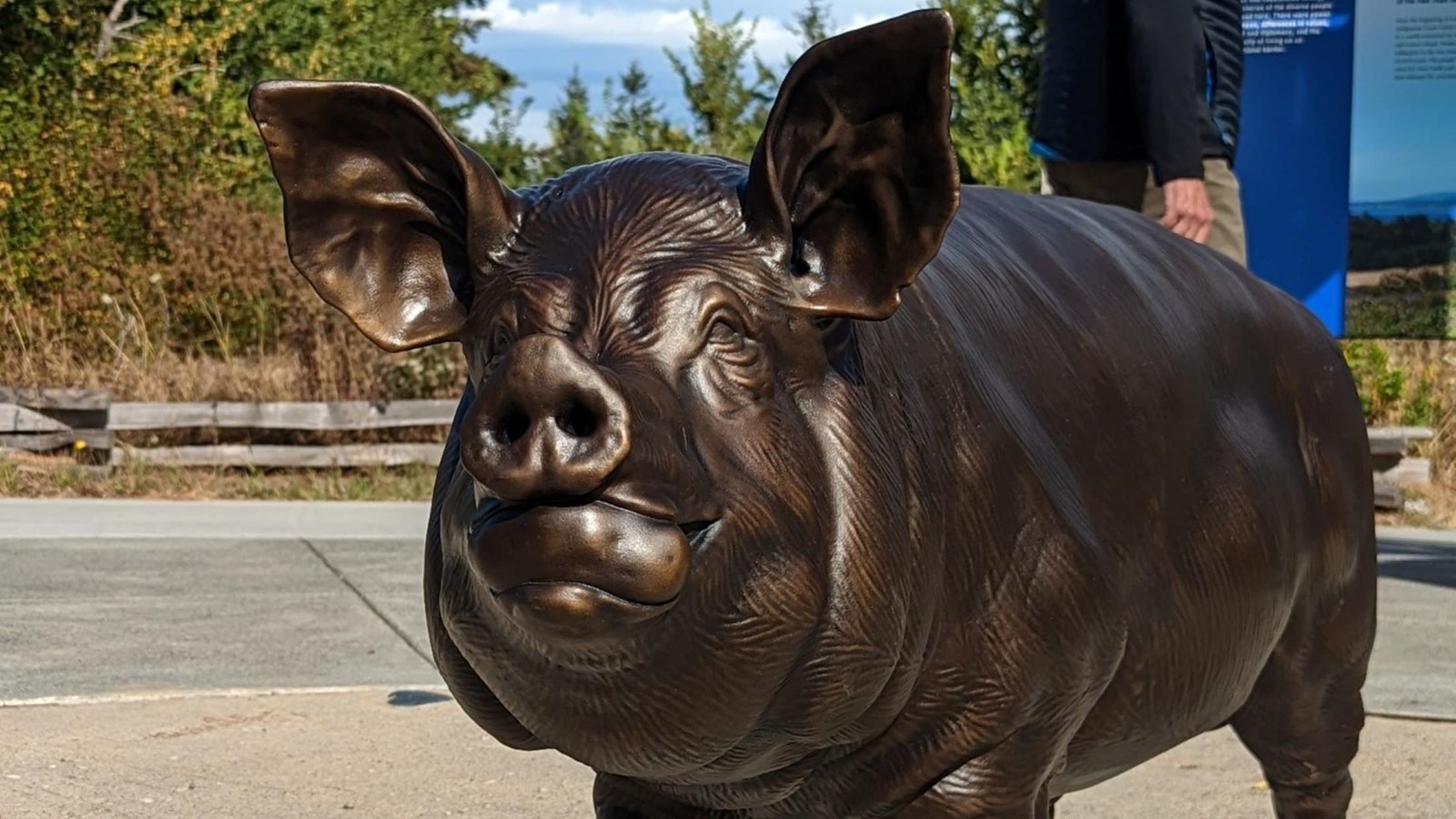Last updated: December 8, 2022
Place
Kaiser Wil-Ham Statue

Quick Facts
Location:
Friday Harbor, WA
This statue, of a Berkshire Boar with a potato in its mouth was created by sculptor Robert MacDonald. It commemorates the potato filching pig whose actions ignited The Pig War. On the morning of June 15, 1859, a Hudson’s Bay Company owned pig began rooting in the small farm plot of American farmer Lyman Cutlar. This had not been the first time an HBC pig had gotten into Cutlar’s crop, and in a fit of pique, Cutlar shot and killed the pig after a short chase. Though some chroniclers have claimed that the pig was a particularly prized animal, no evidence exists to suggest that it was unusual, but was instead just an ordinary Berkshire Boar.
Cutlar knew that he was in the wrong for killing this pig, because in 19th century farm culture it was farmer’s responsibility to prevent errant free-ranging livestock like pigs out of their property. To make amends, Cutlar visited the Belle Vue Sheep Farm and offered reparations to farm manager Charles Griffin. Griffin quoted the unquestionably outrageous price of $100 for the pig’s life, causing Cutlar to explode with anger. Cutlar’s actions had played into Griffin’s hands. Griffin had long been angered by the approximately 20 Americans who had recently been occupying his company’s sheepfolds and treating them as their personal farms. In the aftermath of the pig’s death, Griffin began exerting legal force to eject Cutlar and the other Americans who had moved onto San Juan Island in the past year.
American resistance to Griffin’s plans was far more vehement than he had anticipated. Not only did Cutlar threaten to use deadly force against any British official who trespassed on what he regarded as his land, but his friends reported the incident to American military officials. This report eventually made its way to General William Harney who deployed American forces onto San Juan Island on July 27, 2022, igniting the Pig War.
This statue’s name honors Kaiser Wilhelm I, the man whose actions eventually ended the boundary dispute on San Juan Island. Kaiser Wilhelm, the first emperor of Germany, a nation he played a leading role in creating, held arbitration hearings in Switzerland in 1871-72, which were designed to finally settle the disputed British-American international boundary in the San Juan Islands.
Three German legal experts listened to arguments and counter-arguments presented by American and British diplomats and attorneys over where the boundary should be. After months of hearings, two out of three experts voted for the American boundary claim and one argued that not enough information had been presented. The Kaiser decided that this was sufficient judgement to endorse the American boundary and on October 21, 1872 declared that the Haro Strait would be the international boundary making San Juan Island into U.S. Territory.
Cutlar knew that he was in the wrong for killing this pig, because in 19th century farm culture it was farmer’s responsibility to prevent errant free-ranging livestock like pigs out of their property. To make amends, Cutlar visited the Belle Vue Sheep Farm and offered reparations to farm manager Charles Griffin. Griffin quoted the unquestionably outrageous price of $100 for the pig’s life, causing Cutlar to explode with anger. Cutlar’s actions had played into Griffin’s hands. Griffin had long been angered by the approximately 20 Americans who had recently been occupying his company’s sheepfolds and treating them as their personal farms. In the aftermath of the pig’s death, Griffin began exerting legal force to eject Cutlar and the other Americans who had moved onto San Juan Island in the past year.
American resistance to Griffin’s plans was far more vehement than he had anticipated. Not only did Cutlar threaten to use deadly force against any British official who trespassed on what he regarded as his land, but his friends reported the incident to American military officials. This report eventually made its way to General William Harney who deployed American forces onto San Juan Island on July 27, 2022, igniting the Pig War.
This statue’s name honors Kaiser Wilhelm I, the man whose actions eventually ended the boundary dispute on San Juan Island. Kaiser Wilhelm, the first emperor of Germany, a nation he played a leading role in creating, held arbitration hearings in Switzerland in 1871-72, which were designed to finally settle the disputed British-American international boundary in the San Juan Islands.
Three German legal experts listened to arguments and counter-arguments presented by American and British diplomats and attorneys over where the boundary should be. After months of hearings, two out of three experts voted for the American boundary claim and one argued that not enough information had been presented. The Kaiser decided that this was sufficient judgement to endorse the American boundary and on October 21, 1872 declared that the Haro Strait would be the international boundary making San Juan Island into U.S. Territory.
